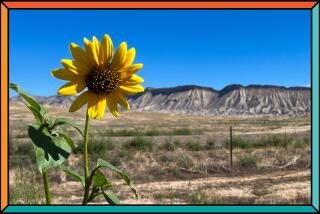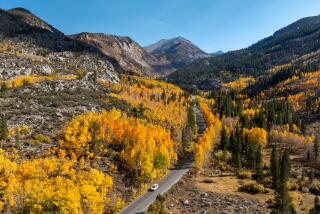Ready to Burst : Expectations Riding High for Best Desert Wildflower Show Since ’75
Forget Arizona Highways. Grab your own camera, load it with Kodacolor 25 and take the best weather pictures San Diego County has to offer:
Spring wildflowers are reigning in the desert this month.
Stunning yellow sunflowers. Cream-colored, brown-eyed primroses. Dazzling white desert lilies. Vibrant purple verbena. And maybe one of the most startling of all desert sights this spring: green grass.
Like an explosion at a Crayola factory, colors are erupting in the Anza-Borrego Desert State Park more wildly than they have in years, as if trying to make up for years of drought and the more subtle--if not monotonous--tones of desert tans and browns.
“We’re anticipating a very good year this year, and that’s understating it,” said a gleeful Fred Jee, who has spent 17 years as an Anza-Borrego park ranger. “This is easily the best year we’ve had in the past five, and it might match ’75.
“And I’ve never seen the desert as green as this. It looks like a golf course.”
Gloria Greene, a volunteer naturalist at the park headquarters, added: “People think of the desert in terms of stickily, prickly things and dry bushes. But it’s so much more than that--and this year, it’s going to be great, just great. The flowers are going to be marvelous.”
This, thanks to nature’s contractors: winter rains and warm spring temperatures.
The winter rains washed the protective coatings off the seeds that otherwise would have held them captive in dormancy another season--as was their plight more often than not over the past five or six years. Warm temperatures then coaxed the seeds along into the spring bouquet.
The flower show has begun already and should peak around mid-month, Jee said. But don’t rush unnecessarily down the grade onto the desert floor; later-blooming species, including white-petaled cactus, will be flowering into early April, he expects.
But what a capricious Mother Nature gives, she can take away. Heavy rains can pound the flowers into submission. High winds can blow them away. And unseasonably hot weather can shrivel their petals.
It hasn’t happened so far, and Jee won’t focus on any possible curve balls. He’s just rejoicing in the moment.
“It’s great to see people coming out to the park--and smiling,” he said. “This is our time to show off. We want people to come into contact with the desert, the fact that it is here and fragile, and deserves to be protected.”
The park has 100 volunteers staffing shifts seven days a week at the park headquarters and elsewhere, to answer questions and give directions to the floral hot spots.
Jee even updated the park’s recorded telephone message to include tips on what flowers are blooming and where they can best be spotted--if they’re not hidden by grass. The number is 767-4684.
And the park’s handout map includes a special insert highlighting some of the best floral displays to be found. Like down Henderson Canyon Road, or on California 78 east of Ocotillo Wells, or the primitive campground in Blair Valley.
“We can provide people with a good deal of information so they can go out and discover for themselves things they haven’t seen for a long time--or have never seen,” Jee said.
Tourists aren’t the only ones benefiting by the spring bloom. Not only are local businesses strutting their stuff during their favorite of the four seasons, but the desert’s native residents are thriving this spring.
It’s an ecosystem enveloped in riches.
“When the flowers are out, you’ve got the ants and bees, and all the animals that prey on the insects are doing well, too--the field mice, kangaroo mice, ground squirrels. . . . And the birds. The ravens, the ground doves, the road runners, the morning doves . . . and the carnivorous animals--the coyotes, the bobcats, the mountain lions, the badgers. . . .”
Jee can’t name them all.
Benefiting by the spring bouquet, too, are the bighorn sheep, those majestic animals for whom the park was established as a preserve. The nearly 920-square-mile state park is the largest in California.
Normally the 200 or so sheep hang out in the higher elevations, but some have been seen at lower elevations, including several sightings in the accessible Borrego Palm Canyon. The sheep dine on vegetation and will do well for themselves this spring.
“All in all, the food chain is very actively working this year,” Jee said, “because there’s been enough of everything for every aspect of that chain to share in the abundance.”
Jee is crossing his fingers that the sphinx moth caterpillar, which swooped down into the park last year and devoured what spoils there were of a late-spring blossom, like some uninvited guest who crashed the party, goes away.
“Actually, he ate the party,” Jee said of the pest. “But we haven’t seen it this year.”
So, springtime is Jee’s favorite season, right?
“When you spend all year out here, you find subtleties throughout each season,” he said. “And I’ve been here long enough to where I don’t see any one season being better or worse than another.
“I just appreciate every season as it comes along. Living in the desert is like drinking your favorite wine. Not every Bordeaux is the same. Some years are better than others.
“This is a good year.”
More to Read
Sign up for The Wild
We’ll help you find the best places to hike, bike and run, as well as the perfect silent spots for meditation and yoga.
You may occasionally receive promotional content from the Los Angeles Times.






